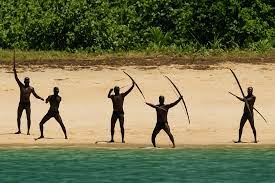Counting people during a national census is usually a straightforward task.
But what happens when the community you’re trying to count refuses any contact—and even reacts with deadly force to outsiders?
This is the difficult situation India faces with one of the world’s last truly isolated tribes: the Sentinelese, who live on North Sentinel Island.
A Tribe That Rejects All Contact
The Sentinelese people have remained virtually untouched by modern civilization.
Known for their fierce protection of their home, they have a history of attacking anyone who tries to set foot on their island.
Officials now find themselves in a tough spot—how do you count a population that doesn’t want to be counted without putting them or census workers in harm’s way?
Deadly Consequences of Contact
Past encounters have had tragic outcomes.
In 2006, two Indian fishermen lost their lives after accidentally drifting too close to the island.
Reports say they were brutally killed with axes, and their bodies displayed on bamboo poles as a warning.
Similarly, after the 2004 tsunami, the tribe fired arrows at a military helicopter sent to check on them, clearly signaling their desire to stay isolated.
Census Efforts Put on Hold
India’s upcoming national census in 2027 raises the question of how to count the Sentinelese safely.
Since 2014, the Indian government officially recognized their right to live without disturbance and has created strict exclusion zones enforced by naval patrols to keep outsiders away.
This means census takers cannot simply visit the island like they do with other populations.
Exploring Technology With Caution
To avoid direct contact, India is considering drones or satellite imaging to estimate the tribe’s numbers from a distance.
However, experts worry about both the accuracy and ethics of such surveillance.
Dr. M Sasikumar, an anthropologist, questions whether remote technology can truly capture an accurate population count or if it is appropriate to do so at all.
Health Risks and Ethical Concerns
Beyond counting, there’s a huge risk of exposing the tribe to diseases.
Groups like Survival International warn that the Sentinelese have no immunity to common illnesses such as flu or measles, which outsiders carry unknowingly.
Even a single case could be devastating for their survival.
Similar Challenges With the Shompen Tribe
It’s not only the Sentinelese under threat.
The Shompen people, a semi-nomadic tribe on Great Nicobar Island, also remain elusive.
Numbering just over 200, they live deep in dense jungle and have avoided contact with modern society.
Government plans to develop airports and ports there have raised alarms from human rights and genocide experts, who fear such projects threaten the tribe’s very existence.
A History of Failed Counts and Fatal Attempts
The government has never been able to fully count these tribes.
In 2011, only a partial census was completed for the Shompen, and the Sentinelese population was only estimated from afar—about 15 individuals.
Attempts to interact with the Sentinelese have sometimes ended in tragedy, like the 2018 killing of American missionary John Allen Chau.
After several secret visits trying to convert them, he was met with deadly resistance.
Recent Incidents Highlight Ongoing Risks
Even recently, individuals like Mykhailo Viktorovych Polyakov risked their lives (and the tribe’s health) by illegally visiting North Sentinel Island.
Authorities arrested him after a risky nine-hour boat trip, where he left a can of Coke as an offering.
Experts condemned the visit as reckless and dangerous for everyone involved.
What Lies Ahead for These Isolated Tribes?
With census deadlines approaching and development pressures increasing, the fate of these isolated tribes hangs in the balance.
Balancing respect for their autonomy and safety with the government’s need to collect data is an unprecedented challenge.
How India navigates this sensitive issue could set important precedents for protecting isolated peoples worldwide.



